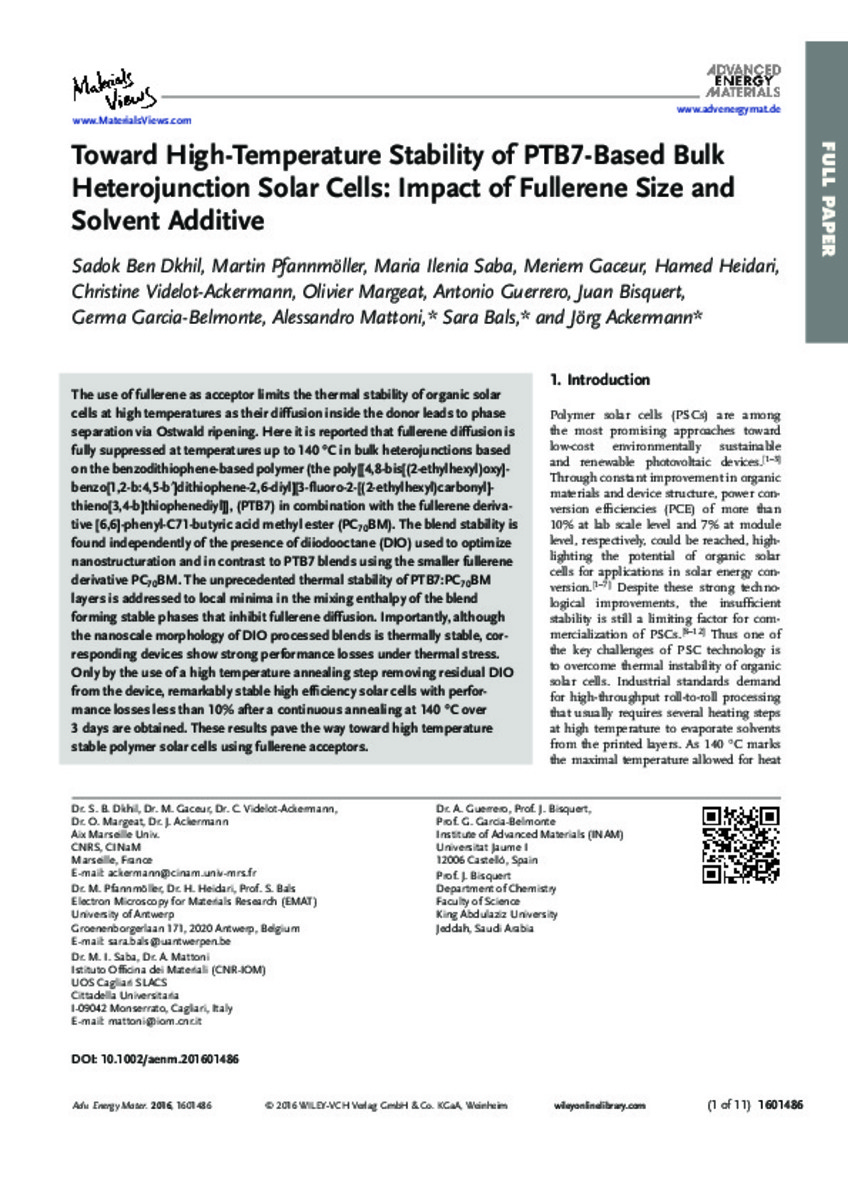Mostrar el registro sencillo del ítem
Toward High-Temperature Stability of PTB7-Based Bulk Heterojunction Solar Cells: Impact of Fullerene Size and Solvent Additive
| dc.contributor.author | Dkhil, Sadok Ben | |
| dc.contributor.author | Pfannmöller, Martin | |
| dc.contributor.author | Saba, Maria Ilenia | |
| dc.contributor.author | Gaceur, Meriem | |
| dc.contributor.author | Heidari, Hamed | |
| dc.contributor.author | Videlot-Ackermann, Christine | |
| dc.contributor.author | Margeat, Olivier | |
| dc.contributor.author | Guerrero, Antonio | |
| dc.contributor.author | Bisquert, Juan | |
| dc.contributor.author | Garcia-Belmonte, Germà | |
| dc.contributor.author | Mattoni, Alessandro | |
| dc.contributor.author | Bals, Sara | |
| dc.contributor.author | Ackermann, Jörg | |
| dc.date.accessioned | 2017-03-07T10:46:59Z | |
| dc.date.available | 2017-03-07T10:46:59Z | |
| dc.date.issued | 2017-02 | |
| dc.identifier.citation | DKHIL, Sadok Ben, et al. Toward High‐Temperature Stability of PTB7‐Based Bulk Heterojunction Solar Cells: Impact of Fullerene Size and Solvent Additive. Advanced Energy Materials, 2016. | ca_CA |
| dc.identifier.uri | http://hdl.handle.net/10234/166517 | |
| dc.description.abstract | The use of fullerene as acceptor limits the thermal stability of organic solar cells at high temperatures as their diffusion inside the donor leads to phase separation via Ostwald ripening. Here it is reported that fullerene diffusion is fully suppressed at temperatures up to 140 °C in bulk heterojunctions based on the benzodithiophene-based polymer (the poly[[4,8-bis[(2-ethylhexyl)oxy]- benzo[1,2-b:4,5-b′]dithiophene-2,6-diyl][3-fluoro-2-[(2-ethylhexyl)carbonyl]- thieno[3,4-b]thiophenediyl]], (PTB7) in combination with the fullerene derivative [6,6]-phenyl-C71-butyric acid methyl ester (PC70BM). The blend stability is found independently of the presence of diiodooctane (DIO) used to optimize nanostructuration and in contrast to PTB7 blends using the smaller fullerene derivative PC70BM. The unprecedented thermal stability of PTB7:PC70BM layers is addressed to local minima in the mixing enthalpy of the blend forming stable phases that inhibit fullerene diffusion. Importantly, although the nanoscale morphology of DIO processed blends is thermally stable, corresponding devices show strong performance losses under thermal stress. Only by the use of a high temperature annealing step removing residual DIO from the device, remarkably stable high efficiency solar cells with performance losses less than 10% after a continuous annealing at 140 °C over 3 days are obtained. These results pave the way toward high temperature stable polymer solar cells using fullerene acceptors. | ca_CA |
| dc.description.sponsorShip | The authors acknowledge financial support by the French Fond Unique Interministériel (FUI) under the project “SFUMATO” (grant number: F1110019V/201308815) as well as by the European Commission under the Project “SUNFLOWER” (FP7-ICT-2011-7, grant number: 287594). Generalitat Valenciana (ISIC/2012/008 Institute of Nanotechnologies for Clean Energies) is also acknowledged for providing financial support. The authors further acknowledge financial support via ERC Starting Grant Colouratoms (335078). | ca_CA |
| dc.format.extent | 11 p. | ca_CA |
| dc.format.mimetype | application/pdf | ca_CA |
| dc.language.iso | eng | ca_CA |
| dc.publisher | Wiley | ca_CA |
| dc.relation.isPartOf | Advanced Energy Materials Volume 7, Issue 4, February 2017 | ca_CA |
| dc.rights | © 2016 WILEY-VCH Verlag GmbH & Co. KGaA, Weinheim | ca_CA |
| dc.rights.uri | http://rightsstatements.org/vocab/InC/1.0/ | * |
| dc.subject | additive | ca_CA |
| dc.subject | bulk heterojunction | ca_CA |
| dc.subject | polymer solar cells | ca_CA |
| dc.subject | PTB7 | ca_CA |
| dc.subject | stability | ca_CA |
| dc.title | Toward High-Temperature Stability of PTB7-Based Bulk Heterojunction Solar Cells: Impact of Fullerene Size and Solvent Additive | ca_CA |
| dc.type | info:eu-repo/semantics/article | ca_CA |
| dc.identifier.doi | http://dx.doi.org/10.1002/aenm.201601486 | |
| dc.rights.accessRights | info:eu-repo/semantics/openAccess | ca_CA |
| dc.relation.publisherVersion | http://onlinelibrary.wiley.com/doi/10.1002/aenm.201601486/full | ca_CA |
| dc.type.version | info:eu-repo/semantics/acceptedVersion |
Ficheros en el ítem
Este ítem aparece en la(s) siguiente(s) colección(ones)
-
FCA_Articles [501]
Articles de publicacions periódiques







